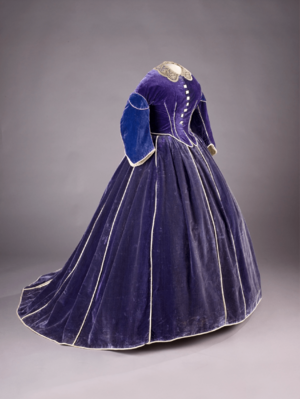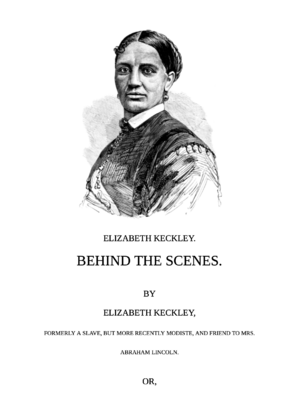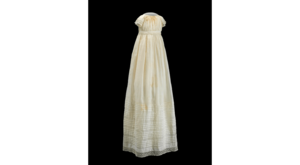Elizabeth Keckley facts for kids
Quick facts for kids
Elizabeth Keckley
|
|
|---|---|
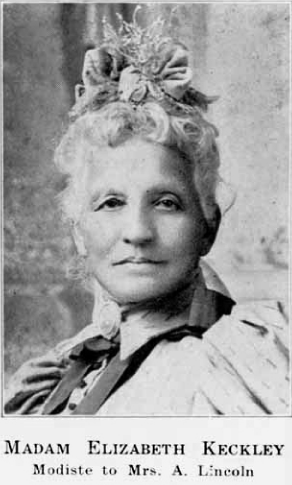 |
|
| Born | February 1818 Dinwiddie County Court House, Dinwiddie, Virginia
|
| Died | May 1907 (aged 89) |
| Occupation | Seamstress, Author |
| Children | George Kirkland |
Elizabeth Hobbs Keckley (born February 1818 – died May 1907) was an amazing American woman who lived in Washington, D.C.. She was a talented seamstress, a brave activist, and a writer. She is most famous for being the personal dressmaker and close friend (or confidante) of Mary Todd Lincoln, the wife of President Abraham Lincoln.
Elizabeth was born into slavery. She was owned by her father, Armistead Burwell, and later by his daughter, Anne Burwell Garland, who was also Elizabeth's half-sister. Elizabeth started working at just four years old, taking care of a baby. She faced very harsh treatment from the Burwell family and their friends.
As she grew up, Elizabeth became a skilled seamstress. The Garland family realized they could make money from her sewing. The money she earned helped support their large family of seventeen people.
In November 1855, Elizabeth bought freedom for herself and her son in St. Louis, Missouri. She then moved to Washington, D.C. in 1860. There, she started her own dressmaking business, which became very successful. She even hired 20 other seamstresses! Her clients included important women like Varina Davis, the wife of Jefferson Davis, and Mary Anna Custis Lee, the wife of Robert E. Lee.
After the American Civil War, Elizabeth Keckley wrote a book about her life called Behind the Scenes: Or, Thirty Years a Slave and Four Years in the White House. It was published in 1868. This book shared her experiences as an enslaved person and also gave a look into the lives of the Lincoln family, especially Mary Todd Lincoln. Some people found the book controversial because it shared private details about the Lincolns.
Contents
Elizabeth Keckley's Early Life and Slavery
Born into Slavery
Elizabeth Keckley was born into slavery in February 1818. Her birthplace was Dinwiddie County Court House, Dinwiddie, Virginia, near Petersburg. She was the only child of her mother, Agnes, who was a light-skinned Black woman. Agnes, also called "Aggy," was a "house slave" who learned to read and write, even though it was against the law for enslaved people. She made clothes for 82 people, including the 12 members of the Burwell family and the 70 people they enslaved.
Elizabeth learned from her mother that her father was Armistead Burwell. The exact relationship between Agnes and Burwell is not fully known. Burwell allowed Agnes to marry George Pleasant Hobbs, an enslaved man who could read and write. He lived and worked at a neighbor's house. Sadly, Hobbs' owner moved far away, and Agnes and George were separated. They never saw each other again, but they wrote letters for many years. Elizabeth later said that her stepfather's old letters, "full of love," were some of her most treasured memories.
Elizabeth was owned by Burwell, who was a colonel in the War of 1812, and his wife Mary. She lived in their house with her mother. Elizabeth started working at just four years old. The Burwells had four young children, and Elizabeth was made the nursemaid for their baby, Elizabeth Margaret. She was punished harshly if she didn't take care of the baby properly. One time, she accidentally tipped the cradle, and the baby rolled onto the floor. Mary Burwell beat her severely for this. As she grew older, Elizabeth helped her mother make clothes.
Teenage Years and Hardship

When Elizabeth was 14, in 1832, she was sent to live with Robert Burwell, the eldest son of her owners. Robert was Elizabeth's half-brother. She was the only servant for Robert and his new wife, Margaret Anna Robertson, in Chesterfield County, Virginia. Margaret treated Elizabeth very badly for the next four years. The family later moved to Hillsborough, North Carolina. There, Robert was a minister and ran the Burwell School for girls from his home. Elizabeth said that Margaret seemed to want to hurt her.
Margaret even asked a neighbor, William J. Bingham, to help "break" Elizabeth's spirit. When Elizabeth was 18, Bingham tried to beat her. Elizabeth bravely refused, saying she was grown and that only her master had the right to whip her. Bingham tied her hands and beat her until she had bleeding marks. He tried to beat her several more times over the next few weeks. Each time, Elizabeth tried to hide her pain and tears. Finally, Bingham changed his mind, cried, and said it would be wrong to beat her anymore. He asked for her forgiveness and promised not to hurt her again, a promise Elizabeth said he kept.
Around 1836, when she was 18, Elizabeth was given to a friend of her owner, Alexander M. Kirkland. In 1839, she gave birth to his son, whom she named George, after her stepfather.
Becoming Free
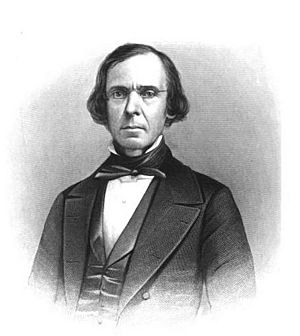
Elizabeth was later sent back to Virginia to serve Ann Burwell Garland, her half-sister, and Ann's husband, Hugh A. Garland. The Garlands moved to St. Louis, Missouri in 1847. Elizabeth, her mother Aggy, and her son George went with them. Elizabeth's skills in childcare and sewing were very important to the family.
Elizabeth became a very skilled seamstress. She worked long hours, and all the money she earned supported the Garland family, who were having money problems. Living and working in St. Louis for nearly 12 years allowed Elizabeth to meet many free Black people. She also made connections with white women, which helped her later when she became a free dressmaker.
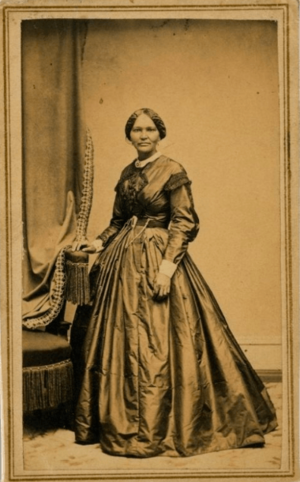
In St. Louis, Elizabeth met James Keckley. She refused to marry him until she and her son were free, because she did not want any more children to be born into slavery. She asked Hugh A. Garland to free them, but he refused at first. For two years, she worked to convince him, offering to buy her freedom. In 1852, he agreed to free them for $1,200 (which is about $44,000 today). His wife, Anne, put the agreement in writing in 1855.
Elizabeth "Lizzie" Le Bourgeois, one of Elizabeth's supporters, helped her by collecting money from friends to loan to Elizabeth. With this money, Elizabeth was able to buy her and her son's freedom. She officially became free on November 15, 1855. Her papers show that she was married to James Keckley by that date. She stayed in St. Louis until she paid back the $1,200 loan. After that, she planned to leave St. Louis and James Keckley.
Elizabeth Keckley's Career
Starting Her Business
In 1860, Elizabeth sent her son, George Kirkland, to Wilberforce University in Ohio, a school for Black students. That same year, she moved to Baltimore, Maryland. She stayed there for six weeks, hoping to teach young Black women how to cut and fit dresses. However, she realized she couldn't earn enough money there to support herself and her son.
Dressmaker in Washington, D.C.

Elizabeth decided to work as a seamstress in Washington, D.C. But there was a problem: free Black people needed a special license to live in the city for more than a short time. One of her supporters, Miss Ringold, asked Mayor James G. Berret to give Elizabeth a license, and he did, for free. Miss Ringold also confirmed that Elizabeth was a free woman, which was another requirement.
Elizabeth slowly built up her list of clients and had plenty of work. She made a beautiful silk dress for Mary Anna Custis Lee, the wife of Robert E. Lee. Mrs. Lee wore it to a dinner party for the Prince of Wales (who later became King Edward VII). Everyone complimented her dress, and Elizabeth's business quickly grew. She hired 20 seamstresses to work at her business on 12th Street. It usually took two to three weeks to make each dress. Elizabeth focused on fitting the clothes perfectly, while her seamstresses did most of the sewing. She was very skilled at shaping fabric and making clothes fit wonderfully. The Smithsonian Institution says she was known as "the dressmaker in D.C. because her garments had extraordinary fit." Her dresses were expensive, but she sometimes earned more money from getting the fabric than from actually making the clothes.
Adele Cutts Douglas, the wife of Stephen A. Douglas, was one of her clients. Elizabeth later became the favorite seamstress for Varina Davis, the wife of Senator Jefferson Davis. Mrs. Davis and her husband even talked about the possibility of war while Elizabeth was present. Elizabeth made clothes for Mrs. Davis and her children.
Mrs. Davis introduced Elizabeth to Margaret McLean of Maryland. Margaret offered to introduce Elizabeth to the newly elected President Abraham Lincoln and his wife, Mary Todd Lincoln. Elizabeth hired seamstresses to finish a dress for Margaret, and then Margaret set up a meeting for Elizabeth with Mary Todd Lincoln the following week.
Working for Mary Todd Lincoln
Elizabeth Keckley met Mary Todd Lincoln on March 4, 1861, the day Abraham Lincoln became president. The next day, they had an interview. Mary Lincoln chose Elizabeth to be her personal dressmaker (or modiste) and personal dresser. This began when Mrs. Lincoln was feeling very stressed about getting ready for an event at the White House.
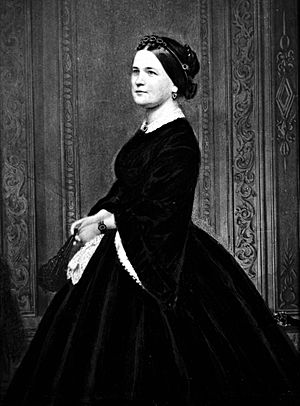
Elizabeth made clothes in a simpler, more elegant style of Victorian fashion. Her designs had clean lines and less ribbon or lace. Mrs. Lincoln was known for wearing clothes with floral patterns, bright colors, and youthful styles. The dresses Elizabeth made for her were more sophisticated.
Today, there are not many examples of Elizabeth's work left. This is partly because people often took fabric from old dresses to make new ones. Also, there were no labels to clearly show which clothes she had made. However, there is a purple velvet gown that Mary Lincoln wore to Lincoln's second inauguration. It is now kept at the Smithsonian Institution's National Museum of American History. The Chicago History Museum has a green and white plaid day dress with a cape that she might have made. A black silk dress with strawberries on it, possibly made by Elizabeth, is at the Abraham Lincoln Presidential Library and Museum in Illinois.
In 1861, Mary Lincoln went to Mathew Brady's photography studio in Washington. She had pictures taken while wearing an off-the-shoulder dress made by Elizabeth.
Elizabeth Keckley was graceful and dignified, and she became Mary Lincoln's best friend. By 1862, she often visited the Lincolns' private living areas and was present during family conversations. Sometimes, she even helped President Lincoln fix his messy hair to look presentable. Elizabeth later wrote that she "loved him for his kind manner towards me," because he treated her like "the white people about the house."
In April 1862, enslaved people in Washington, D.C. were freed. Even though Elizabeth had bought her own freedom earlier, she was featured in a newspaper article about formerly enslaved people who had become successful. Since many newly freed people came to Washington, Elizabeth started the Ladies' Freedmen and Soldier's Relief Association. This group helped people until they could build new lives for themselves. The Lincolns supported her efforts and visited the camps where these newly freed people, called contrabands, lived. Elizabeth even introduced Sojourner Truth to Abraham Lincoln. She was also with the Lincolns when they visited Richmond, Virginia after the Civil War ended.
Elizabeth had a calming way about her and helped Mary Lincoln during times of stress and sadness. Elizabeth herself had lost her son during a Civil War battle in August 1861. So, she was a great source of strength and comfort for Mary Lincoln after her son Willie died in February 1862, and especially after President Lincoln was assassinated. Elizabeth received some of Mary Lincoln's belongings after the assassination. She got Mary Lincoln's dress from the second inauguration, the blood-stained cloak and bonnet from the night of the assassination, and some of the President's personal items.
Elizabeth went with Mary Lincoln and her children to Illinois after the assassination. In late 1867, Mary Lincoln was deeply in debt. She tried to sell her jewelry and clothes to get money. Elizabeth helped her by going to New York to find someone to sell the items. Even though Mary Lincoln used a fake name, the effort became public. Mary Lincoln was heavily criticized for selling items connected to her husband's presidency. In the end, the plan failed, and they spent more money than they made.
Elizabeth Keckley later gave her Lincoln items to Wilberforce College to help them raise money after a fire in 1865. This upset Mary Lincoln.
Behind the Scenes Book
In 1868, Elizabeth Keckley published her book, Behind the Scenes. This book told her own story of slavery and also gave a special look into the lives of the Lincolns. Elizabeth described how she rose from slavery to become a successful businesswoman with her own staff. She showed herself as an educated, middle-class Black woman. She focused on how she overcame challenges and developed her business skills. While she mentioned the harshness of slavery, she didn't spend much time on those difficult events.
The book shared details about the Lincolns, especially Mary Todd Lincoln. At that time, people didn't know much about the Lincolns' private lives. The book showed Mary Lincoln as a "loving wife and mother" and a "strong-willed" First Lady. But it also revealed that she could be "high tempered, full of fear and anxiety, self-centered and often self-pitying." The editor, James Redpath, included letters from Mary Lincoln to Elizabeth in the book. Many people criticized Elizabeth for sharing Mary Lincoln's private information.
Elizabeth wrote the book to try and improve Mary Lincoln's reputation and to explain the "old clothes scandal" of 1867. She also hoped the money from the book would help Mary Lincoln financially. Advertisements called the book a "literary thunderbolt" and a "great sensational disclosure."
At the time, it was unusual for a Black woman, especially one who had been enslaved, to write about the private lives of important white people. People felt that Elizabeth had crossed social boundaries by sharing private details about Mary Lincoln. Her friendship with Mary Lincoln was special because it mixed her role as an employee with a true friendship, which was not common for people of different races and social classes back then.
Historians often say that Elizabeth lost her friendship with Mary Lincoln because of the book. However, Elizabeth herself said that their friendship continued and they kept writing to each other. She did lose many of her dressmaking clients. Robert Lincoln, Abraham and Mary's son, convinced the publisher to stop printing the book because he felt it was embarrassing to his family. The book was published again in the early 1900s. At first, people read it for information about the Lincolns. Now, it is mostly valued for Elizabeth Keckley's own story of her life as an enslaved girl and woman.
Later Years
Elizabeth Keckley continued to work and earn a living until about 1890. In 1892, she was offered a job at Wilberforce University in Ohio. She became the head of the Department of Sewing and Domestic Science Arts. The next year, she had an exhibit at the Chicago World's Fair, representing Wilberforce. She had a mild stroke in 1893 and had to resign from her job.
Ladies' Freedmen and Soldier's Relief Association
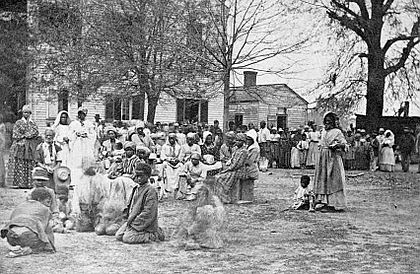
Elizabeth Keckley started the Contraband Relief Association in August 1862. She received donations from both the Lincolns, as well as other white supporters and wealthy free Black people. The organization changed its name in July 1864 to the Ladies' Freedmen and Soldier's Relief Association. This new name showed that their mission had grown after Black soldiers started serving in the United States Colored Troops.
The organization provided food, shelter, clothing, and medical care to recently freed people. These people were called contrabands because they were not legally free and were seen as "seized property" during the war.
Elizabeth wrote about the contrabands in Washington, D.C. in her book. She said that formerly enslaved people would not find an easy life in Washington D.C., but that "the road was rugged and full of thorns." She saw that their "appeal for help too often was answered by cold neglect." One summer evening, Elizabeth saw a festival organized by white people to help sick and wounded soldiers. She thought that free Black people could do something similar to help the poor freedmen. She suggested to her Black friends that they form "a society of colored people to labor for the benefit of the unfortunate freedmen."
The association used independent Black churches for their meetings and events. These included the Twelfth Baptist Church, Fifteenth Street Presbyterian Church, Israel African Methodist Episcopal Church, and Siloam Presbyterian Church. The organization held fundraisers with concerts, speeches, readings, and festivals. Elizabeth asked important Black figures like Frederick Douglass and Henry Highland Garnet to support the group. She also got help from important white figures like Wendell Phillips.
In its first year, the association collected $838.68, and in the second year, $1,228.43. During that time, they received 5,150 pieces of clothing. About $600 of the first year's money came from Black-run or mostly Black organizations.
The association gave out clothes, food, and shelter to the freedmen. They also sent money to many people. For example, they sent $50 to sick and wounded soldiers in Alexandria, Virginia. The group hosted Christmas dinners for sick and wounded soldiers. They also gave food to other organizations. The association helped place African-American teachers in the new schools built for Black children. The whole community recognized and thanked the association for its kindness.
Even though the association's work was very important, it was often forgotten in later history books. However, it set an example and showed the need for organizations to help the poor and displaced Black community. The association's work within the Black community helped create independence for Black people. By working together, the association created an organization run by and for African Americans.
Elizabeth Keckley's Personal Life
When Elizabeth lived in St. Louis, she met James Keckley again, whom she had known in Virginia. He said he was a free man. Elizabeth and James were allowed to marry by November 15, 1855. They were married for eight years. During that time, Elizabeth learned that James was still enslaved. He was not a helpful partner, relied on her for support, and faced mistreatment. She separated from him, and their marriage ended when he died.
Elizabeth's only child, George Kirkland, had a very light skin color. He was more than three-quarters white. In 1861, when the Civil War started, he joined the Union Army as a white soldier. He was a private in the 1st Missouri Volunteer Infantry. Sadly, he died on August 10, 1861, during the Battle of Wilson's Creek. After some difficulty proving his racial identity, Elizabeth received a pension as his survivor. It was $8 a month at first, later raised to $12 (about $450 today) for the rest of her life. After she could no longer work, this pension was her only income.
In the 1860s, Elizabeth lived at a boardinghouse owned by her friends, Mr. and Mrs. Walker Lewis. Mr. Lewis was a successful caterer who had also bought his freedom from slavery. Elizabeth also had living quarters at her business on 12th Street. She was present for the birth of one of the Lewis daughters, Alberta Elizabeth Lewis. Mrs. Lewis made Elizabeth the godmother of her daughters. Elizabeth made a christening gown for her infant goddaughter, which is now in the collection of the National Museum of American History. After Mrs. Lewis died, Elizabeth helped raise the girls.
Alberta Elizabeth Lewis-Savoy later described Elizabeth Keckley as "a woman of refinement and culture, always careful of her associates—She carried herself gracefully and well poised and had a striking and pleasing personality."
Elizabeth was a member of the Union Bethel Church until 1865, when she joined the 15th Street Presbyterian Church in Washington. For a time, she lived in Washington, D.C. with John Gray, a successful caterer during the Lincoln administration. By the late 1890s, she returned to Washington. She lived in the National Home for Destitute Colored Women and Children, an organization she had helped to create. While there, she was known for her cultured and refined manner and her intelligence. She was also very private.
Elizabeth Keckley died in May 1907, while living at the National Home in Washington, D.C. She was buried at Columbian Harmony Cemetery. In 1960, her remains were moved to National Harmony Memorial Park in Landover, Maryland, when Columbian Harmony Cemetery closed. A historical marker across the street from where the home used to be remembers her life.
Jennifer Fleischer wrote about the different fates of Elizabeth and Mary Lincoln: "Perhaps the most poignant illustration of the different fates of these two women is found in their final resting places. While Mary Lincoln lies buried in Springfield in a vault with her husband and sons, Elizabeth Keckley's remains have disappeared. In the 1960s, a developer paved over the Harmony Cemetery in Washington where Lizzy was buried, and when the graves were moved to a new cemetery, her unclaimed remains were placed in an unmarked grave—like those of her mother, stepfather, and son."
On May 26, 2010, 103 years after her death, a special marker was placed at Elizabeth Keckley's grave in National Harmony Memorial Park.
Elizabeth Keckley's Legacy and Honors
- The dress that Elizabeth Keckley designed for Mary Todd Lincoln to wear at her husband's second inauguration ceremony is now kept by the Smithsonian Institution's National Museum of American History.
- Elizabeth Keckley designed a quilt made from fabric scraps left over from dresses she made for Mrs. Lincoln. This quilt is at the Kent State University Museum. It is shown in the book, The Threads of Time, The Fabric of History (2007), by Rosemary Reed Miller, which features Elizabeth Keckley among many other African-American designers.
- The former school in Hillsborough, North Carolina, where Elizabeth Keckley worked for Rev. Robert Burwell, is now a museum called the Burwell School Historic Site. Its website shares information about Elizabeth Keckley's life.
- On December 12, 2018, The New York Times published an obituary for Elizabeth Keckley as part of their Overlooked series. This series tells the stories of amazing people whose deaths were not reported by the newspaper at the time.
- In 2022, actress Sarah Jessica Parker wore a dress to the Met Gala that was inspired by one of Elizabeth Keckley’s designs from 1862 for Mary Todd Lincoln.
Elizabeth Keckley in Culture
- Films
- In Steven Spielberg's film Lincoln (2012), Elizabeth Keckley is played by actress Gloria Reuben.
- Literature
- Tim Jorgenson's novel Mrs. Keckley Sends Her Regards (2007) shows Elizabeth Keckley's close friendship with both Abraham and Mary Lincoln.
- Jennifer Chiaverini’s novel Mrs. Lincoln’s Dressmaker (2013) focuses on Mrs. Keckley's friendship with Mrs. Lincoln.
- George Saunders' novel, Lincoln in the Bardo (2017), includes parts from Mrs. Keckley's autobiography.
- Plays
- Tazewell Thompson's play Mary T. & Lizzy K. opened in March 2013 in Washington, D.C.
- Paula Vogel’s A Civil War Christmas, which opened in New York in December 2012, featured Elizabeth Keckley as a main character.
See also
- List of slaves
- Abraham Lincoln and slavery


